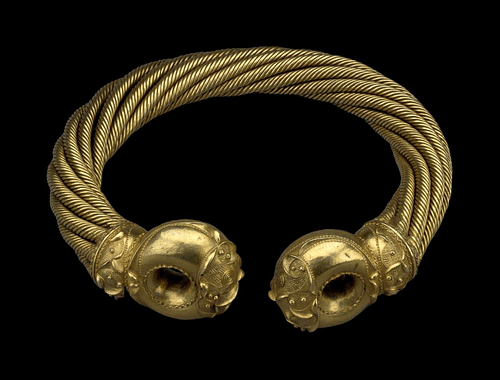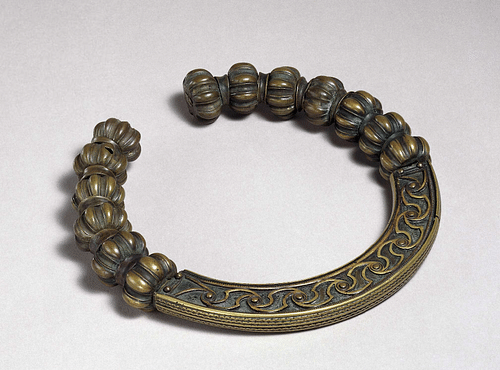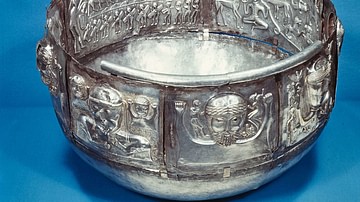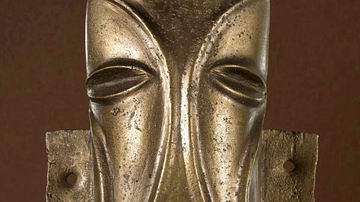In ancient Celtic cultures, torcs were a common form of jewellery and were made from bronze, copper, silver, and gold. Torcs were not just exquisite works of Celtic art but also identified the wearer’s status and perhaps were believed to have spiritual properties. Depictions of gods and Celtic warriors in ancient art often show these figures wearing a torc around their necks. Many surviving torcs have been found in shallow pits, most likely put there for a ritual purpose as a votive offering or simply for safekeeping, and, with some weighing over a kilo (2.2 lbs) in gold, they were certainly a handy and sometimes highly decorative form of portable wealth.
Torc Designs
Torcs (sometimes spelt torques, from the Latin) were meant to be worn around the neck and wrist and have been found across Celtic Europe from Iberia to Bohemia. They were not, however, unique to Celtic cultures despite their strong association with this form of jewellery. Torcs were worn by men, women, and probably children, too.
Celtic torcs were made using metals such as gold, silver, copper, iron, and bronze. They are formed either with smooth, hollow, or twisted bands. Several bands could be twisted around themselves or spiralled around a core of iron or even wood. Some torcs have been given extra shine using the mercury gilding technique which leaves a pure gold surface after the mercury has been evaporated under heat.
Many Celtic torcs have terminals which are fat rings but other types exist, such as in the form of serpent heads, an animal associated with strength and abundance. Examples from Spain and Portugal sometimes have a very thin band and heavy terminals shaped like an hourglass. In contrast, the gold torc from the 5th-century BCE Vix hoard in Burgundy, France, has spherical terminals and a small winged horse where the terminal and rope sections meet. The Niederzier hoard found near Düren in Germany (1st century BCE) has gold bracelets which appear to be torcs with prominent terminals but are complete rings. Then there is an unusual example of a torc with a twisted form like a corkscrew and with disc terminals, which was found in the Stirling Hoard from Stirlingshire, Scotland (300-100 BCE). Finally, in Roman Britain in the 1st and 2nd century CE a new form of torc was created which had a flat bar and a line of multiple beads at the terminals. A fine example of this type is the copper alloy Lochar Moss torc from Scotland, which now resides in the British Museum in London.
Ritual Offerings or Safe Deposits?
The Stirling hoard and many others like it consisted of several torcs buried together in shallow pits but whether this was as a votive offering or merely as a safe deposit is difficult to determine. The presence of coins with torcs might hint at the latter purpose but the sheer quantity of gold in some hoards would suggest they were too valuable to be owned by a single person or family and so perhaps these were ritual hotspots which generations of people dedicated valuables to over many years. This idea of a scared area is further supported by such hoards as the Snettisham hoard in England (see below) which consisted of 12 separate deposits. Quite why such a plain landscape without any geographical features of note was considered sacred remains a mystery. Another hint at a ritual burial is the fact that in some hoards where multiple torcs have been found each bracelet has been threaded through another to form a chain. Of course, too, the two ideas may run together: deposits were made for both ritual purposes and as a means of safekeeping these objects, protected as they were by the sacredness of the site. One thing which is more certain is that torcs are surprisingly rare in male burials and more common in the tombs of women and girls, where they are most often made of bronze.
Gods & Torcs
Torcs likely had a spiritual symbolism, and it is perhaps for this reason depictions in art of Celtic gods often show them wearing or holding torcs. Perhaps the most famous examples can be seen in the Gundestrup Cauldron, a c. 100 BCE silver and partially gilded vessel with rich relief decoration. An interior panel of the cauldron shows a godlike figure with antlers sitting cross-legged and wearing a torc around his neck. The figure also holds a torc in his right hand. In addition, several of the godlike figures on the exterior of the cauldron are wearing torcs around their necks. In addition, the horned figure identified as Cernunnos on the 1st-century CE Gallo-Roman Nautae Parisiaci monument has a torc hanging from each of his horns. Another possible depiction of Cernunnos, this time in the form of a 1st-century BCE bronze figure found in Bouray near Paris, has him wearing a torc around his neck. Finally, another famous sculpture, the sandstone Mšecké Žehrovice head from the Czech Republic, which dates to around the 2nd century BCE, also wears a thick torc around the neck.

However, despite the numerous depictions in art across Celtic Europe, the precise symbolic significance of torcs to the ancient Celts is not known. As with other precious objects like Celtic bronze shields, torcs were given as votive offerings to gods. The historian Gnaeus Pompeius Trogus, writing in the 1st century BCE, recorded that a gold torc was dedicated to the goddess Minerva in Massilia by Catamandus, a Gaul prince.
Warriors & Torcs
Celtic warriors of higher status frequently wore jewellery of gold, bronze, or iron around their necks and wrists as a mark of their rank in society. Many Celtic warriors wore a torc necklace, and depictions in art show this, the most famous example being the Dying Gaul statue of the Capitoline Museums in Rome. The marble figure dates to c. 230-220 BCE and was commissioned by Attalos of Pergamon (r. 241-197 BCE) in honour of his victory over the Galatians. The Greek historian Polybius (c. 208-125 BCE) noted that the Gauls who invaded Italy in 225 BCE wore gold necklaces and bracelets. When this Celtic army was defeated their torcs and battle standards were hung up for public display in the Capitol of Rome. The Roman writer Cassius Dio (c. 164 - c. 229/235 CE) describes Boudicca (d. 61 CE), chief of the Iceni, as wearing a twisted gold necklace in battle. Finally, Diodorus Siculus of Sicily, writing in the 1st century BCE, noted of Celtic warriors:
They amass a great quantity of gold which is used for ornament not only by the women but also by the men. They wear bracelets on their wrists and arms, and heavy necklaces of solid gold, rings of great value and even gold corselets.
(in Allen, 21)

Torcs perhaps were thought to in some way protect the wearer just as animal totems were carried on shields and swords. In that case, they were not always successful, and enemies of the Celts were certainly happy to collect torcs as war trophies. In 361 BCE, one Roman general, Titus Manlius, was even given the nickname Torquatus after he defeated and killed a warrior chief from Gaul in single combat and then took his torc as a victory prize. A much more spectacular haul was made in 191 BCE when a Roman army defeated a Celt army at Bologna and amassed a war booty of 1,500 gold torcs.
The celts themselves may well have considered torcs, if not as a currency per se, at least as a handy form of portable wealth, especially so when an army was on the move. Nevertheless, that this particular form of jewellery did have some significance other than the value of its material is evident in such instances as the gift the Gauls gave the Roman emperor Augustus (r. 27 BCE - 14 CE), a massive gold torc far too heavy to ever wear. The Roman appreciation of torcs certainly continued long after they had conquered Celtic tribes. Roman soldiers often wore miniature torcs on their chest armour, which had been given as a reward for valour. From these miniaturised torcs a popular form of jewellery then developed; the penannular brooch.
The Snettisham Great Torc
The Snettisham Great Torc was part of the Celtic Snettisham burial hoard found near the village of Snettsham in Norfolk, England. It was discovered by accident by a farmer ploughing his field in 1950 CE. Today it is on display in the British Museum. Made using a gold alloy (the other metals are silver and copper), it weighs a little over one kilo (2.2 lbs) and was meant to be worn around the neck. It measures 56 cm (22 in) in diameter and dates to 150-50 BCE. It was likely buried around 50 BCE, a date suggested by the lucky presence of a coin which was stuck in one of the terminals and radiocarbon data from wooden objects found near it. Other objects buried with the torc in a small pit were a sheet gold bracelet and several other gold torcs, including one which was broken. On top of the gold torcs was a layer of soil and then another group of silver torcs. Collectively, these objects are known as the Snettisham burial hoard.
The body of the Great Torc is composed of 64 strands which are twisted into eight ropes, each comprising eight strands. Each individual strand is 1.9 mm (0.07 in) thick. The two terminals are highly decorative. The terminals are hollow and were cast using moulds and welded to the ropes. The terminals mix embossed areas with chased 'basketwork', the craftworker using very fine tools to achieve this and to sharpen up the cast work and remove any imperfections.
The Belstead Brook Torc
The Belstead Brook torc was part of a hoard of five gold torcs found near Belstead Brook, Ipswich, England in 1968 CE. The torcs were found by accident by construction workers. An additional torc was later discovered nearby. The torcs were likely deposited all together c. 75 BCE, although the torcs themselves date to the period from the mid-2nd century BCE. The Belstead Brook Torc is now on display in the British Museum.
The loop terminals of the torc have designs in relief of bosses and scrolls, motifs typical of late Iron Age Britain. The terminals were then cast onto the two twisted solid bars using the lost wax technique. The two bars of the body are fluted. The torc measures 18.6 cm (7.3 in) in diameter and weighs 867 grammes (1.9 lbs).
The Trichtingen Torc
The Trichtingen torc was discovered near the town of that name in Germany. Perhaps dating to the 2nd century BCE, it is another miracle find, discovered by chance as workers cleared drainage channels. The torc is now on display in the Landesmuseum Württemberg, Stuttgart. It measures 29.5 cm (11.5 in) in diameter and weighs 6.7 kilos (14.8 lbs) and so was too heavy to be actually worn. It was, then, either made as a votive offering or once adorned a statue.
The torc is made of silver-plated iron and displays outstanding artistic skill both in its detail and plating technique. The terminals represent bovine heads facing each other, with each animal wearing a torc of its own. The torc is perhaps originally from Thrace or Persia or was made imitating the style of art prevalent in those locations where bovine heads were a popular motif. Decorative details and comparative finds, meanwhile, suggest it may have been made in Gaul. The torc may have travelled as a diplomatic gift or been an object of interregional trade. If anything, then, this object, like many others, illustrates the interconnected nature of Celtic Europe as ideas in art and techniques in crafts spread from one end of the continent to the other.










